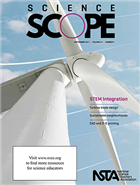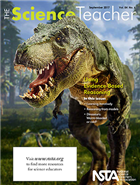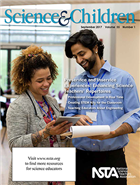Ideas and inspiration from NSTA’s September 2017 K-12 journals
By Mary Bigelow
Posted on 2017-09-25

Commentary: Reasoning Versus Post-Truth in The Science Teacher is an important read in a time when dependence on unverified information from social media seems to be more prevalent than using trusted sources that value reasoning.
Science Scope – STEM Integration
From the Editor’s Desk: STEM Integration: A Tall Order: “The shift from teaching math and science in silos to intertwining them with technology and engineering makes education more relevant to students’ lives through exposure to authentic problems.”
Articles in this issue that describe lessons include a helpful sidebar (“At a Glance”) documenting the big idea, essential pre-knowledge, time, and cost. The lessons also include connections with the NGSS.
- Designing a Sustainable Neighborhood: An Interdisciplinary Project-Based Energy and Engineering Unit in the Seventh-Grade Classroom describes student collaborations in designing energy-efficient buildings. The article has examples of student work.
- Teaching Thermal Energy Concepts in a Middle School Mathematics-Infused Science Curriculum includes a 5E lesson that goes beyond traditional lab lessons by infusing math skills related to the investigation.
- Students often explore motion using toy cars and ramps. Exploring the Engineering Design Process Through Computer-Aided Design and 3-D Printing show how students can go further, designing and constructing their own cars. The 5E lesson includes a rubric.
- What happens in the schoolyard after the dismissal bell? Students investigate and submit their findings in What’s in Your School Yard? Using Citizen Science Wildlife Cameras to Conduct Authentic Scientific Investigations
- Teacher’s Toolkit: STEM Career Bingo raises students’ awareness of how STEM careers are interconnected.
- Integrating Technology: Enhancing a Scientific Inquiry Lesson Through Computer-Supported Collaborative Learning describes how students apply engineering design processes to solve a problem. The article also shows how the lesson was modified after initial implementation.
- Citizen Science: Navigate Classroom Citizen Science Throughout the School Year with Journey North incorporates technology into a study of monarch migration.
- Colleagues share their ideas and strategies in this month’s Listserv Roundup: Add More STEAM to Your Classes.
These monthly columns continue to provide background knowledge and classroom ideas:
- Scope on the Skies: Cassini’s Grand Finale
- Disequilibrium: Colorful Covalent Bonds
- Science for All: Breaking the Cycle: Thoughts About Building Grit in the Classroom
- Teacher to Teacher: Written Assessment in Three Dimensions
For more on the content that provides a context for projects and strategies described in this issue, see the SciLinks topics Biodiversity, Careers in Science, Conductors/Insulators, Covalent and Ionic Bonds, Energy Transformations, Forces and Motion, Insects, Kinetic/Potential Energy, Law of Conservation of Energy, Migration, Renewable Sources of Energy, Satellite Technology, Sound. Sustainable Development, Winds
Read more from The Science Teacher and Science & Children:
 The Science Teacher – Using Evidence-Based Reasoning
The Science Teacher – Using Evidence-Based Reasoning
Editor’s Corner: Evidence-Based Reasoning: “Cable news and social media now allow us to view only the information and views that confirm our own biases, often accepted without evidence and with great confidence….Teachers—especially science teachers—are in a unique position to reaffirm the priority of facts and evidence-based reasoning.”
The lessons described in the articles include connections with the NGSS.
- Idea Bank: Setting the Stage: Your First Week of Science Class illustrates that it’s never to early in the school year to involve students in investigations (this one is about reaction times).
- The Case of Dinosaur Metabolism includes a lesson in which students research thermoregulation in dinosaurs and use a claim-evidence-reasoning process to guide their thinking. A rubric for C-E-R is included, along with examples of student work.
- The lesson described in Reasoning From Models integrates probes, physical models, simulations, and mathematical models to help students understand their learning about electric circuits.
- Modeling Periodic Patterns has ideas for repurposing an investigation of chemical reactions to include evidence-based reasoning.
- Rather than a once-and-done cookbook lab, Learning Iteratively shows how a series of activities can build on each other as students develop and refine models and reflect on their explanations.
These monthly columns continue to provide background knowledge and classroom ideas:
- Science 2.0: Enhancing Google Sheets for the Classroom
- Focus on Physics: Eight Tips for New (and not so new) Teachers
- The Green Room: Exploring Our Public Lands
- Health Wise: Be Prepared for Opioid Overdoses
- Career of the Month: Epidemiologist
- Right to the Source: A Nose for Poison Gas Saved Lives
For more on the content that provides a context for projects and strategies described in this issue, see the SciLinks topics Chemical Reactions, Circulatory System, Dinosaurs, Drugs and Drug Abuse, Electric Circuits, Electric Current, Halogens, Homeostasis, Mapping, Metabolism, Metals and Nonmetals, National Parks, Paleontology, Periodic Table, Respiratory System
 Science & Children – Preservice and Inservice Experiences: Enhancing Science Teachers’ Repertoires
Science & Children – Preservice and Inservice Experiences: Enhancing Science Teachers’ Repertoires
Editor’s Note: Learning and Teaching (and Vice Versa): “This issue includes a variety of professional development strategies used in preservice and inservice settings. Not only do they provide ways to enrich your classroom science teaching, they also provide ideas concerning how you might go about sharing your expertise with colleagues and beyond.”
The lessons described in the articles include connections with the NGSS.
- Teachers learn by observing another teacher in Professional Development in Real Time, reflecting on their own teaching, and trying new 5E lessons themselves.
- Creating STEM Kits for the Classroom describes a win-win project: Teachers design “kits” based on lessons they created. Who learned more—the designers or the students?
- Integrating Science Methods With Professional Development illustrates a “third space” methods course connecting pre-service teachers with students in a real school setting to try out their lessons.
- Instead of a set of demonstrations, try a family STEM night with the ideas in Scientists Overnight.
- The authors of Discussing Science in Professional Learning Communities share their experiences in the effective form of professional development. The article includes discussion protocols and group roles.
- Preservice early-childhood teachers help children discover What’s in Our Soil?
- Teaching Through Trade Books: The Tool and Eye includes 5E lessons that address animal adaptations.
- Engineering Encounters: Teaching Educators About Engineering describes a hands-on professional development session designed to introduce teachers to engineering at the elementary level.
These monthly columns continue to provide background knowledge and classroom ideas:
- The Poetry of Science: What Do Scientists Do?
- Science 101: Can Electromagnetic Waves Affect Emotions?
- The Early Years: Experiencing Inquiry
- Formative Assessment Probes: Uncovering Preservice Teachers’ Ideas About Magnetism and Formative Assessment
For more on the content that provides a context for projects and strategies described in this issue, see the SciLinks topics Adaptations of Animals, Decomposers, Electromagnetic Waves, Fluids and Pressure, Magnets, Rocket Technology, Roots, Seed Germination, Soil, Vibrations, Worms
Disclaimer: The views expressed in this blog post are those of the author(s) and do not necessarily reflect the official position of the National Science Teaching Association (NSTA).


